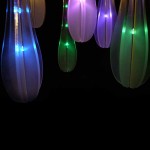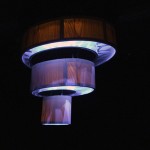Today we were surprised that our article “Scientometric Analysis Of The CHI Proceedings” is linked on the SIGCHI homepage:
Developing Novel Extensions to Support Prototyping for Interactive Social Robots
Martijn ten Bhömer, Christoph Bartneck, Jun Hu, Rene Ahn, Tuyls, Karl, Frank Delbressine, and Loe Feijs
Abstract – Lego Mindstorms NXT is a platform highly suitable for prototyping in the field of interactive social robotics. During a technology masterclass at Eindhoven University of Technology students from the department of Industrial Design have developed five novel extensions (sensors and actuators) for the Lego Mindstorms NXT which extend the ability of Lego to prototype for robotics even further. Applications include a water-pump, GPS sensor, wireless sensor bridge, optical mouse sensor and a magnetic grabber. In this paper we will present these extensions and showcase applications in which these extend possibilities of Lego Mindstorms NXT to a new level.
Keywords: robot, Lego, Mindstorms, NXT, social, prototyping
FULLTEXT: PDF HTML REFERENCE: BibTeX EndNote
LIVE HISTORY – A Vision for the Nationaal Historisch Museum (NHM)
This video shows a vision on how visitors could experience the upcoming Nationaal Historisch Museum. The video was created by the Department of Industrial Design at the Eindhoven University of Technology. More information is available at http://nhm.id.tue.nl/
AdMoVeo: An Educational Robotic Platform for Learning Behavior Programming
This video, made by Sjriek Alers, has been shown as part of a Demo on DeSForM 360, the 5th International Workshop on Design & Semantics of Form & Movement October 26 & 27, 2009 Taipei, Taiwan. It is a compilation of some of the student work for the assignment Creative Programming for designers (Creapro) Showing what the students have learned in behavioral programming with the AdMoVeo robot platform and using the Arduino.
[youtube]http://www.youtube.com/watch?v=O3e0VzHyAkA[/youtube]
Most of the design students do not have inherent affinity towards programming and electronics. The AdMoVeo robotic platform is designed, purely for teaching the industrial design students basic skills of programming and for motivating and encouraging the design students to explore their creativity with their passions in graphical and behavioral design.
Danah Boyd: Remarks from Panel on “Scientometric Analysis of the CHI Proceedings” at CHI 2009
Danah had some very interesting remarks with regard to our paper “Scientometric Analysis of the CHI Proceedings”. See http://www.danah.org/papers/talks/CHI2009.html.
FULLTEXT: PDF HTML REFERENCE: BibTeX EndNote
DOI: 10.1145/1518701.1518810
DG000 Competency II
[nggallery id=6]
Flow: Contextual Information Exchange
by Olaf Corduwener. [Complete Report, PDF, 1.7M]

In his report, “…The concept is visioned to be a one-of-a-kind lighting installation that reflects the contextual status of a (public) building or space. One-of-a-kind means that it is not an actual product, but it’s tailored and made specifically for a certain place. The actual contextual status it communicates therefore also depends on the placement. The way it communicates this contextual information was approached in a rather artistic way, as in the metaphorical flowing or raining of coloured light. The metaphor ‘flow’ as in the flow of people (the context of movements) or being in mental flow (immersed in the activity; the context of activity). Coloured lighting as output was chosen for its attractiveness and diverse capabilities. The lighting is placed inside dozens of glass-formed raindrops hanging from the ceiling, animating the falling of rain in diverse colours, speed and frequency. It is not an individual drop that has a particular meaning. Instead, it’s the total picture the complete installation radiates that gives it its meaning. The different output variables (colour, diversity in colour, speed of falling, frequency of falling, etc) do not reflect different input variables, but change and work simultaneously to give an impression of the contextual status…”
Increasing comfort on long-haul air travel in an economy class environment
by Rick van de Westelaken.
Almost 2 billion people are traveling by airplane every year. A large group of passengers experience discomfort or stress in some degree during a flight. This is not surprising because on the one hand humans have not evolved naturally to fly and are better suited to terrestrial travel. On the other hand airlines try to fit as many chairs in a plane as possible to keep the ticket prices low with limited seating space in economy class as result.
In 2006 an European funded project entitled “SEAT” (smart technologies for stress free air travel) was set up to investigate and develop new innovative ways to improve comfort in air travel. The final master project described in this report is executed as part of the SEAT project and has the objective to improve the perceived level of comfort in air travel. Because the term “comfort” is quite broad it was further defined as reducing psychological stress and supporting passengers with their activities during a long-haul flight.
Read More: [Final Mater Project Report, PDF, 1.7M]
Software Architecture Support for Biofeedback Based In-flight Music Systems
Hao Liu , Jun Hu, Matthias Rauterberg
Abstract In this paper, we present a software architecture support for biofeedback in-flight music systems to promote stress free air travels. Once the passenger sits in a seat of a flight, his/her bio signals are acquired via non intrusive sensors embedded in the seat and then are modeled into stress states. If the passenger is in a stress state, the system recommends a personalized stress reduction music playlist to the passenger to transfer him/her from the current stress state to the target comfort state; if the passenger is not in a stress state, the system recommends a personalized non stress induction music playlist keep him/her at comfort state. If the passenger does not accept the recommendation, he/she can browse the in-flight music system and select preferred music himself/herself.
Keywords in-flight music; biofeedback; healthy air travels; stress reduction.
FULLTEXT: PDF HTML REFERENCE: BibTeX EndNote
DOI: 10.1109/ICCSIT.2009.5234489
Movow: Contextual Information Exchange
by Meerthe Heuvelings. [PDF, 2.3M]

“In the ‘Contextual Information Exchange’ project, the focus was on communicating the context of one user to another user. In this project I focused on creating a feeling of connectedness over distance. To create this feeling of connectedness, I did research to the missing-links between face-to-face and distant communication and concluded that virtual shadows of real physical objects or people can create a feeling of physical presence on ‘the other side’.
In this project we worked in three iterations, the last two iterations were done individually. In the second iteration I developed a concept in which the shadows of stones can form a new medium of communication over distance. The stones on one side are transfered into shadows on the other side and vice versa. This will create a decorative piece of stones and shadows, that is made with use of two persons that live on a distance from each other.
The final concept is the ‘Movow’, which stands for ‘Moving Shadow’. In this concept the amount of people and the speed with which these people move are detected in one room, and transfered into shadows of the ‘Movow’ light object in another room. The ‘Movow’ is able to generate shadows according to the amount of people and movement. When there are not that much people in the other room, only the lower ring of the prototype will be lit. When the amount of people increases, the light will ‘grow’ to the ceiling. The speed with which the lights will be circulate in the rings, depends on the movement of the people in the other room. For this concept a prototype is build that represents the light and shadow capabilities of the concept.”